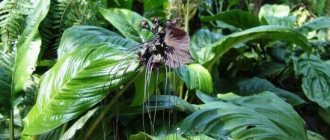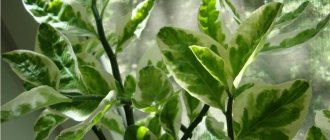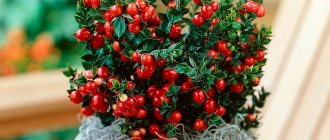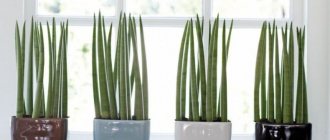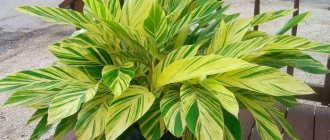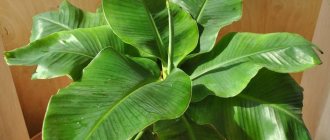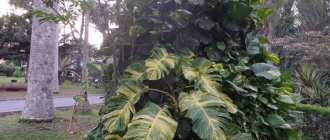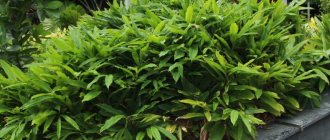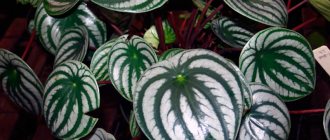The grevillea plant is one of the interesting and unusual large-sized indoor plants. Despite the fact that in size it is still inferior to palm trees or some vines growing at home, grevillea will never go unnoticed against their background. It is a large, but at the same time lush and bright indoor tree, which not only does not weigh down the interior, but also gives it airiness with its filigree greenery and completely exclusive inflorescences that are unlike the flowers we are used to. To be fair, it must be said that this is not the most convenient indoor plant for growing at home due to the requirements for cold wintering and the need for constant adjustment of dimensions. But the flower has its devoted admirers and, on the whole, is certainly worthy of attention.
General characteristics of Grevillea
The genus grevillea includes many species of evergreen plants belonging to the family Proteaceae. The most popular and easiest variety to grow is undoubtedly Grevillea rosmarinifolia, so named because its leaves are very similar to those of rosemary.
The grevillea plant has a fairly strong root system. The above-ground part, dense and slow-growing, consists of thin, branched and flexible branches covered with many small shiny dark green needle-like leaves.
At the tops of the stems, which are on average more than 1 meter high, very decorative flowers appear, special inflorescences collected in a raceme consisting of more than 100 flowers. The red, pink or variegated flowers have no petals and have an elongated calyx.
Judging by the photo of grevillea, the shrub looks very advantageous during the flowering period due to the combination of flaming inflorescences and dark green foliage.
Botanical description
Grevillea is a perennial evergreen plant of the Proteaceae family.
It grows in the form of a shrub or large tree (height up to 35 m), when grown indoors it is limited to a height of 2 m. The interest of flower growers in grevillea is caused by the structure of the leaves. Each leaf is elliptical in shape and simple. Alternately attached leaves make up a leaf plate up to 30 cm long. In general, it resembles a fern frond or thuja needles. The reverse side of the leaves is covered with fine hair, which gives the surface a silky feel. The leaves are soft to the touch and their color is deep green.
Grevillea blooming
How grevillea blooms photo
Grevillea flowers look like long narrow tubes. They gather in large spike-shaped or racemose inflorescences. Flowers can be white, but bright shades predominate (pink, orange, red). By the way, thanks to the sweet nectar, the flowers of certain types of grevillea were eaten by local residents.
Where is it found?
Most types of grevillea are common in the tropics of Australia, some can be found on the islands of New Guinea, Caledonia, Sulawesi, and the Moluccas. Focusing on tropical origin, it is necessary to create appropriate conditions for indoor cultivation: bright lighting, warmth, high humidity.
Grevillea is a flowering plant, but blooms extremely rarely at home. Most often, grevillea is grown as a decorative foliage tapeworm in bright, cool rooms.
The first description of grevillea dates back to 1809, and the name of the plant was given in honor of Charles Greville (English botanist, member of the Royal Society).
Varieties and types of grevillea
The genus Grevillea is one of the most interesting members of the Proteaceae family, with about 200 cultivated species, mainly due to its very showy flowering.
The genus is divided into two parts: one called Anadenia, which includes species that usually have pinnate or serrated leaves (Grevillea robusta belongs to this group), the other is Manglesia, which is characterized by alternating entire leaves. or less needle-like (the species Grevillea juniperina belongs to this group).
Grevillea robusta
Grevillea robusta - this species belongs to the Anadenia section, the largest representative. In optimal conditions it can reach 30 meters in height.
Robusta grevillea can be found in parks and on the avenues of Sochi, Stavropol and Krasnodar Territories. This is a very popular variety due to the beauty of its leaves of various shapes, often feathery with deep lobes, reminiscent in appearance of some ferns.
Robusta Gravillea is used in Sri Lanka as shade for tea plantations. In temperate regions, this species is used exclusively for ornamental purposes, both as an indoor foliage plant in northern regions and outdoors in the subtropical zone.
Grevillea Banksi
Grevillea Banksi - This species is suitable for temperate climates and gardens by the sea. It is a large bush with a very elegant appearance that can take the form of a small tree. It has pinnate leaves with very thin and elongated blades.
The flowers form long terminal spikes with red stigmas and a yellow tip. Perennial specimens reach a height of 10 meters and a width of 5 meters.
Grevillea stenomera
Grevillea stenomera is a beautiful shrub with silvery foliage that reaches a height of about 2 meters, suitable for mild climates. It is characterized by bright red or dark pink inflorescences, from which long pistils and stamens protrude, turning green, and which create a special chromatic contrast.
The species lanigera has a compact, dwarf and drooping habit, sometimes with spreading branches.
It is characterized by small leaves densely packed on stiff and felty branches, the leaves have curled edges and form a dense mass of leaves dotted with red or pink flowers, with contrasts between red and cream or green and cream.
Grevillea lanigera
Grevillea lanigera has good winter hardiness. Recommended varieties are Grevillea lanigera 'Mount Tamboritha', 'Compacta' and 'Clearview John'.
Grevillea thelemanniana is small in size and reaches a maximum height of 1.80 meters. It is characterized by red flowers, collected in dense, perfectly symmetrical panicles, and branches covered with very narrow leaves, sometimes feathery. Over the years it becomes more and more tree-like.
Grevillea juniper
Grevillea juniper is the most common and popular in our country. This is a dense bush of a round shape with lanceolate-linear leaves of a prickly green color.
Among the shrub species, it is undoubtedly the most common, has a rounded shape and bright green, dense and tough foliage. It produces beautiful red, orange or yellow blooms that begin in late spring to mid-summer.
Grevillea juniper inflorescences consist of graceful hanging racemes up to 6 centimeters long.
Its height can reach 2 meters. For this reason, it is widely used to create small hedges with high ornamental value, especially for coastal cultivation. Juniper is distinguished by its exceptional ease of cultivation, richness and early flowering, as well as remarkable frost resistance.
Features of transplantation at home
Until the age of three years, grevillea must be replanted annually. Replant adult plants approximately once every 3-4 years; when grown in a tub, as the tub rots. For adult plants, it is necessary to change the top layer of the substrate annually (carefully remove it to a depth of 5 cm). Replant or replace the substrate in early spring before growth begins.
Each time you replant, slightly increase the diameter of the container. The pot should not be deep; in such conditions grevillea does not develop well.
Be sure to lay a good drainage layer at the bottom of the container, consisting of expanded clay, pebbles, clay shards, and pieces of polystyrene foam. The soil requires loose, nutritious, neutral or slightly acidic reaction. It can be prepared on the basis of 2 parts of coniferous soil, with the addition of 1 part of leaf soil, peat and ½ part of coarse sand, also add brick chips for looseness.
Once the drainage is in place, add a layer of fresh soil into the container. Carefully remove the grevillea from the previous pot and lightly shake off the soil from the roots. If rot is detected, it is necessary to cut off the affected areas and treat the cut areas with a fungicide. After this, place the grevillea in the center of the new container, add the substrate, then press it with your palms on the surface around the stem. Water it a little and move it to a slightly shaded place for a couple of days to adapt.
Growing Grevillea
The plant loves sunny or semi-shaded places, protected from the wind. Mature plants tolerate winter temperatures below 0°C very well.
All plants of this botanical species love slightly acidic, loose, soft and well-drained soils. This plant is very resistant to fungal diseases and is rarely affected by parasites such as aphids and other insects.
Grevillea is propagated by seeds in spring or cuttings in summer. The most common technique is cuttings: in the spring, semi-woody cuttings about 10 cm long are taken from the side shoots.
Rooted cuttings are planted in a mixture consisting of two parts universal soil and one part sand, which should be regularly watered and kept moist. Once established, they are then transplanted into individual containers or in the ground and grown as mature plants.
Grevillea tolerates cold well, so indoor plants grown in pots must be protected from frost and not left in unheated rooms. Young plants grown directly in the ground should be protected with breathable materials.
Pests
More than others, spider mites annoy the plant. The risk of infection increases many times when kept in too warm conditions or excessively dry air. You can often get rid of the problem by simply adjusting the conditions and frequent spraying.
In home and garden interiors, grevillea always plays the role of a soloist; it is never placed in plant groups. This is due not only to its bright individual appearance, but also to the requirements for spacious single growth.
Watering and fertilizing
Although it tolerates periods of prolonged drought very well, it is recommended to water the shrub regularly during vegetative regeneration and in the summer and only when the soil is completely dry.
In the fall, dig a large amount of aged manure or a handful of slow-release granular fertilizer at the base of the bush.
